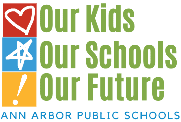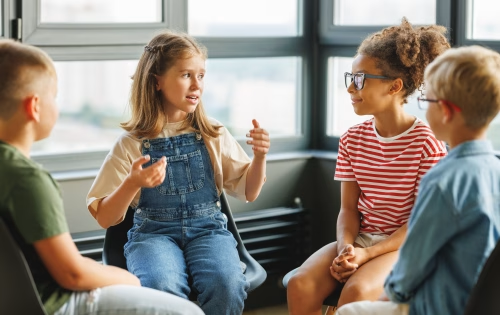Charged with creating spaces that support 21st-century learning needs, AAPS tested a “Flex Room” between two elementary classrooms to design a collaborative, student-first environment.
Studies from both U.S. and international researchers are showing that flexible classrooms are more likely to create a student-centered learning environment, where students and teachers interact and share ideas. This approach contrasts with the traditional, desks-facing-front classrooms that encourage students to simply receive information from a teacher. Open layouts with fewer barriers, multi-use furniture, and natural lighting, can help students feel calm and positive about learning.
Flexible learning spaces also help students take charge of their own learning. Students who can choose where and how they want to work have more control over their education and take more responsibility for learning. The teacher provides the students with templates for how to use the areas, but the students can make adjustments to what works best for their learning style. Studies have shown that teachers observe that flexible classrooms encourage students to learn on their own and work together on projects, better preparing them for teamwork and collaboration in future workplaces.
Informed by this research, Ann Arbor Public Schools (AAPS) approached the design and development of new schools by challenging assumptions about the traditional classroom, and re-visioning what a learning space should look like for student needs in the 21st century. By investing in their future, AAPS is creating schools that will truly prepare young people to be active citizens, members of an adaptive workforce, and participants in the global economy.
As the district prepares to build new schools and renovate existing buildings, stakeholders need to understand how these newly designed spaces will enable students and teachers to embrace technology, adapt to change, and foster positive learning environments. In order to pilot these strategies first, AAPS determined that creating a series of experimental classrooms to introduce the concept in an elementary school setting would provide important data.
This is where the “Mitchell Modular” initiative, a flex room pilot program, comes in.
Key Takeaways
- AAPS tested “Flex Room” spaces in the Michell Modular initiative to understand how students and teachers might use these areas for learning and collaboration.
- The pilot program, along with other creative learning space arrangements, is helping AAPS develop 21st-century classrooms for students.
- Collaborative spaces will apply to teacher areas as well, so that teachers can see how their colleagues are using the new spaces and share ideas and inspiration.
The Pilot: Flexible Learning
Katie Gibson, Technology Consultant for Ann Arbor Public Schools, is leading a multi-year program to test the use of flexible spaces shared by different classrooms. “The flex room is a test driving space,” Gibson said, “based on our efforts to model what a new build would look like.” Gibson’s Instructional Technology Consultant (ITC) team took down existing walls and created two classrooms with glass doors opening into a space between the two rooms.
The goal of the experiment, which is ongoing, is to learn how teachers and students interact and use the space. The district embraced the program by assigning classes to the space for the 2023/2024 and 2024/2025 school years. In order to plan for technology, training and professional development support, the ITC team approached the project with several key questions in mind:
- How can different classroom layouts better support various learning activities or whole-child needs throughout a school day?
- How might teachers have to reimagine student movement within and outside the classroom throughout the school day to minimize loss of instructional time.
- How might teachers reimagine the use of space, pedagogy and technology to build student agency?
- How does student voice play a role in the planning or daily usage of instructional spaces?
- What technology needs to be integrated into the teaching and learning process when there is no front of the classroom?
The flex space project is intended to offer insights into some of these questions. Early lessons have already proved illuminating.
Part 1: From Distraction to Curiosity
Gibson and her team observed that the teacher who moved into the first test classroom immediately put paper over the glass doors into the flex space in order to block out “distractions” from the other room. The ITC team didn’t interfere—they waited to see what would happen. As time went on, the papers started to come down. Some of the furniture arrangements in the test driving space started to show up in this teacher’s room. Then they started to open the door occasionally. Later on, the teacher even left the sliding doors open and allowed their students to make learning choices in this space.
While the typical approach would be to lead with coaching conversations, for the pilot initiative, Gibson elected to lead with curiosity instead. “In the end it was so wonderful to watch that progression of someone going from being uncertain to being open.”
Then the ITC team grew, bringing on lecturers, field instructors, and interns from University of Michigan. Like the teacher, the interns initially started to put up paper, to block the “distraction” of the children. Spotting an opportunity to model the purpose for having the open space, the ITC team asked them to remove the papers. This experience demonstrated how adults were bringing assumptions learned from their own educational backgrounds to the way they interacted with the learning spaces—and that those assumptions would need to be discussed openly. After some coaching from the ITC team, the apprehension began to evolve into creativity. “It was so interesting to watch how they collaborate, show them how to use the space, and be mindful about resetting it.”
Part 2: Transforming the Teachers’ Experience
Gibson’s vision for collaborative learning goes outside the classroom to transform teacher prep periods. “The workroom space for teachers is going to be a collaborative space,” said Gibson. She describes the workroom as having the aura of a “coffee shop.” It will be informal, with tables and places for interactive or solo work. The informal arrangement will give teachers the opportunity to see how others are using tools, items, or plans, and make decisions about how or if they can use these things in their classrooms, too.
Gibson’s experience in the coaching and teacher training areas has prepared her to help teachers adapt to using the new classrooms. “Teacher action research,” Gibson explained, “is how we try things out in our classroom.” Using this method, Gibson coached her teachers to ask “did that help students? Did that push them forward in their learning?” When the answer was “yes” Gibson guided the teachers implementing more of those tactics. Now, with the first year of the “Flex Room” experiment complete, the ITC team is incorporating the data into strategic professional development opportunities for teachers to explore tools, furniture, software, and other teaching supports alongside other teachers. “When we watch others, we’re more inclined to try it,” observed Gibson.
For the 2024/2025 school year, two cohorts of fourth grade students have moved into the experimental classrooms connected by the flex space. Gibson explained that observing and coaching this group is the next step in the action research. “We watched them move into the space, watched them start the school year,” Gibson said. “No one put paper this time, the students are so settled in that they aren’t distracted by each other.” The ITC team is applying their learning from the past school year to guide the teachers through 2024/2025. “We have a lot of work to do,” said Gibson, “the teachers are going to be learning with us.”
Part 3: Students Embrace the New Classroom
Students were intrigued by the classrooms in the ITC team’s experiment. Students were brought into the spaces to participate in designating and naming parts of their room. They named one corner “the Cabin,” an open space they named “the Lodge,” and an outdoor table they named “the Porch.” The ITC team also selected different furniture choices for the test driving space including comfortable seats at the children’s scale that they have the ability to move. This furniture was very favorably received by the students. One student even called her parents to tell them how much she loved the soft furniture in the new classroom. Another group of students, a cohort of children struggling in school, told their teacher that if they were allowed to go to the classroom with the comfortable seats, they would study harder. Dr. Heather Kellstrom, Executive Director of Instructional Technology for AAPS, reinforced the goal of these new flexible classrooms: “we’re trying to meet students where they’re at, provide flexibility, choice, and voice.”
Giving the students the task of arranging the furniture, naming spaces, and organizing their room, has helped the children feel more in control of—and responsible for—their surroundings. This sense of autonomy has also contributed to improved concentration as well as higher quality peer and teacher interactions. Student engagement with the test driving space was remarkable, Dr. Kellstrom shared the surprise of the staff at the extent of the effect these spaces had on the students, “I don’t think we realized some of these small changes like soft seating would bring so much happiness, including students doing better and trying harder. It was really unique.” Flexible classrooms and learning spaces are designed to make the school feel fresh and enjoyable, offering students the chance to make choices and be involved, all while creating a safe and welcoming place to learn. Dr. Kellstrom’s hope is for students, and their parents, to “realize that school can be a joyful place again.”
Applying the Flex Space Data to the AAPS Capital Project Going Forward
“We don’t want people to move into modern teaching spaces with old practices,” Gibson says. “It’s about the kids and how the kids learn best, and we have to get on board with that.” Ultimately, AAPS’ new construction and renovations aim to establish a model for 21st-century learning that prioritizes flexibility, collaboration, and student well-being. Inspired by experiences from the flex room experiment, the district recognizes the value of physical space in shaping educational experiences.
By designing spaces that promote choice, engagement, and independence, AAPS hopes to create a more inclusive and effective learning environment for all students. This approach reflects a commitment to embracing innovative educational strategies that prepare students for the future, supporting both academic success and personal growth through thoughtfully-designed learning spaces.

